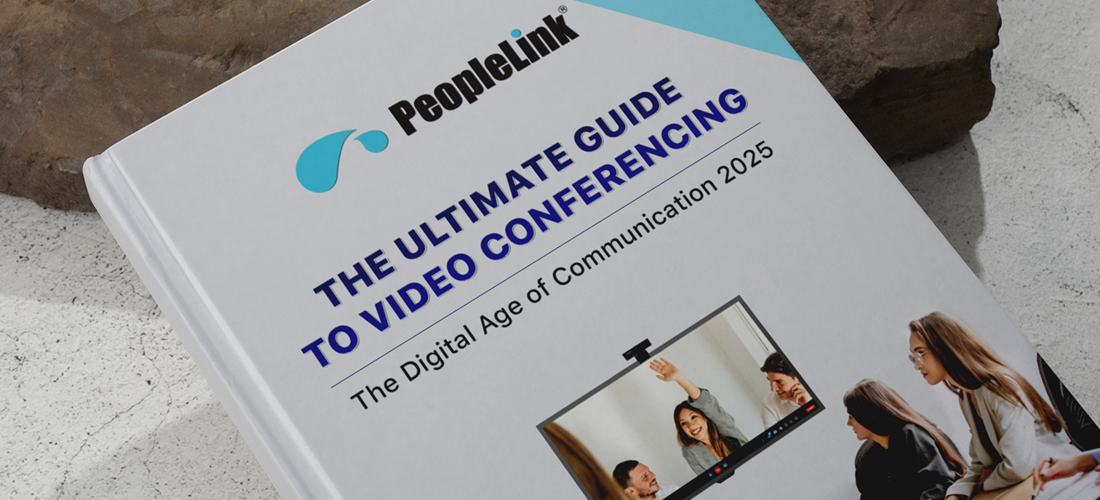The Ultimate Guide to Video Conferencing: The Digital Age of Communication (2025)
- August 21, 2024
- Posted by: PeopleLink
- Category: Blogs

Have you ever wondered how our world has changed? Today, we live in a fast-paced, globally connected world. But have you ever wondered why? One reason is that communication is now faster than ever. Today, you can connect with them anytime and for as long as you want. But how are we able to achieve this? The answer is Video Conferencing.
Video conferencing has changed how people meet, connect, and collaborate. Today, almost every human being uses it in some form. Despite that, many people still don’t know about it in more detail. They still have no idea how it evolved from a niche solution to becoming a global wonder. In this article, we will take you deep into the world of video conferencing.
What is Video Conferencing?
Video conferencing is a communication tool that allows people to meet face-to-face in real-time. Regardless of location, it will let people see and hear each other in real time. This tool is versatile, which means it can be used for various purposes. Whether using it for business meetings, closing deals, virtual interviews, working remotely, learning, or simply connecting with family or friends, it has you covered.
What is the Digital Age of Communication?
The digital age of communication marks a transformative period in how people exchange information and interact with one another. Characterized by the widespread use of digital technologies, this era has significantly changed personal, professional, and social communication. Here are some key aspects and implications of the digital age of communication:
- Email and Messaging Apps: The rise of email, bulk SMS and instant messaging software has made it possible to send and receive messages instantly. This offers real-time communication across the globe.
- Social Media Platforms: Platforms like Facebook, Twitter, TikTok and Instagram have enabled people to share updates, photos, and videos instantly, fostering a new level of connectivity.
- Video Conferencing: Tools like Zoom, Microsoft Teams, and Google Meet have revolutionized how we conduct meetings, collaborate on projects, and stay in touch with friends and family.
- Voice Assistants and Smart Devices: Devices like Amazon’s Alexa and Apple’s Siri have introduced new ways of interacting with technology and accessing information.
- Cross-Cultural Communication: Digital platforms allow communication across cultural and linguistic boundaries, making it easier to engage with diverse audiences and understand different perspectives.
- Accessibility: Digital communication tools have made information more accessible, providing opportunities for individuals with disabilities to engage and participate.
- Online Communities: The internet has facilitated the creation of online communities and forums where people can connect over shared interests, hobbies, or causes.
- Digital Relationships: The digital age has transformed how relationships are formed and maintained, with dating apps and social media playing a significant role in social interactions.
- Abundance of Information: The digital age has brought unprecedented information at our fingertips, sometimes leading to information overload.
- Challenges of Misinformation: The spread of false or misleading information has become a significant issue, necessitating critical thinking and fact-checking to navigate the digital landscape.
Top 3 Benefits of Video Conferencing
Video conferencing solutions have become popular in the last few years. One of the reasons for this is its benefits. Truly, it has improved many people’s lives in many ways. Here are some of its examples:
Face-to-Face Interaction
Video conferencing allows people to interact with anyone they want face-to-face in real time. This is very powerful, as technology has eliminated the need to meet people in person. Thanks to it, we can see the same person anywhere we want in real time.
Cost Savings
Video conferencing helps people in two ways: by eliminating the need for travel and commuting. They can meet the same person virtually in real time from their location. This is very beneficial. It has saved companies a significant amount of money.
Increased Productivity
The third way video conferencing has helped people is by increasing personal productivity. Understand that it saves time when people don’t have to travel and commute anywhere. That saved time can be invested in doing more productive things.
Short History of Video Conferencing Technology
The history of video conferencing dates back to 1927, when AT&T began working on the technology. However, it wasn’t until 1964 that Bell Labs introduced the first commercial picture phone, making video conferencing available to the public.
Early technology was large, complex, and limited in accessibility due to high costs. Video and audio quality were poor, and call durations were limited. However, significant advancements have been made in video conferencing technology, improving video and audio quality experience.
Essential Requirements For Video Conferencing
Conducting video conferencing is not hard. However, it requires some essential tools. Without these tools, it is impossible to conduct even a simple video call. Here is the list of those crucial tools:
Hardware
The first equipment that you need is hardware. This hardware is what every other software will run. That’s why you must choose the right one for you, but it’s not that easy. Choosing the right hardware for your conferencing needs is not that easy. It’s because today, we have so many choices and many different types of hardware in the marketplace.
However, if your needs are greater, you need something else. For example, if you want to conduct a business meeting, you will need better devices than this. You will need a dedicated conference room, a webcam, an audio device, and a speaker.
Video Conferencing Software
The second set of tools you need is a video conferencing platform. A video conferencing platform is software that allows you to join or host a meeting. This software is generally cloud-based, which means you have to download it from a third-party website to use it.
There is one thing to keep in mind. Choosing the best hardware is not enough. That’s just the starting point. Once you do that, it’s time to choose the best video conferencing platform for yourself.
Internet connectivity
The last set of tools that you need is a strong and stable internet connection. A strong and stable internet connection is very important. This is because it dictates what your meeting experience is going to be. Your internet connection speed has a lot to do with the quality of your meeting.
Advantages and Disadvantages of Video Conferencing
Let’s talk about advantages first:
- Convenience and Accessibility: This technology allows individuals to participate remotely from any location with internet access, ultimately saving time and money on travel.
- Increased Collaboration: It promotes real-time communication, file sharing, and document collaboration, enhancing teamwork.
- Cost Efficiency: This technology reduces expenses related to meetings and conferences by eliminating the need for travel, accommodation, and venue rentals.
- Flexibility: It simplifies the process of scheduling meetings across various time zones and makes it easier to accommodate participants’ availability.
- Improved Communication: This technology’s visibility of non-verbal cues and facial expressions aids in better understanding and reduces the likelihood of misunderstandings.
Here are a few disadvantages:
- Technical issues like connectivity problems, audio/video quality, and software glitches can disrupt meetings.
- Participants may also face distractions from their environment or multitasking, potentially reducing focus and productivity.
- There are security concerns related to the risks of data breaches, unauthorized access, and privacy issues associated with transmitting and storing sensitive information.
- High-definition video conferencing also requires significant bandwidth, which may be a limitation in some locations or for some participants.
- Video conferencing can lack the personal interaction and nuances of face-to-face communication, such as body language and personal connection.
Our Suggested Video Conferencing Platforms in 2025
As we have talked so far, to conduct a successful video conference, you must choose the right video conferencing platform for yourself. Choosing the right one is difficult as it requires careful research and planning. However, we have made your job easier. We suggest a few conferencing platforms that stand out the most in 2025. Here they are:
inMeet
The first video conferencing platform on our list is inMeet. It is a rapidly growing video conferencing platform developed by InstaVC. It is a 100% cloud-based application, and because of that, it has eliminated the need to download it. To use it, all you have to do is go to their website and sign up. Any individual with an invitation link can quickly join a meeting through their web browser. We put inMeet on our list because it is one of the platforms in the market that supports 4K UHD video resolution on WEB-RTC.
inClass
inClass is a SaaS-based virtual classroom solution designed to eliminate geographical barriers and convert traditional classroom learning models into a worldwide paradigm. It has made it possible for students and teachers to interact and teach or learn face-to-face from different parts of the world, thus understanding the different perspectives a number of cultures would bring to the table.
inClinic
inClinic is a cloud-based SaaS platform that helps to improve patient-doctor communication, clinic appointment management, and conduct remote consultations. It also removes the worry of ‘hopping’ from one doctor to another, in case one has several ailments and can see various specialists online from home. inClinic also discourages the problem of transportation and provides an easily accessible facility for a patient who does not have a car or stops public transport near the clinic.
Future of Video Conferencing
The future of video conferencing is very bright, as is the future of artificial intelligence, virtual reality, and augmented reality. In fact, we are already seeing their impact. Thanks to them, video calls today feel more natural.
- Immersive Experiences: By integrating VR and AR technologies, virtual meeting environments can become more immersive and interactive, giving participants the feeling of being in the same room.
- Virtual Avatars and Spaces: Customized virtual meeting spaces can enhance remote interactions, making them more engaging and personalized.
- AI-Powered Features: AI has the potential to improve video conferencing with real-time language translation, automated note-taking, and smart scheduling.
- Facial Recognition and Emotion Detection: These technologies can offer insights into participants’ emotional states, helping to gauge engagement and reactions.
- HD Audio and Video: Advances in codecs and compression techniques will enable higher-quality audio and video streams, even on lower-bandwidth connections.
- Seamless Integration: Video conferencing tools will integrate more smoothly with other productivity tools, making scheduling, joining, and managing meetings easier.
- Stronger Encryption: With growing concerns about data security, video conferencing platforms will adopt more robust encryption and security measures.
- Privacy Controls: Enhanced privacy controls allow users to manage how their data is used and shared during and after meetings.
- Hybrid Work Environments: As hybrid work models become more prevalent, video conferencing will be crucial for bridging the gap between remote and in-office employees.
- On-Demand Meetings: Improvements in mobile video conferencing technology will facilitate the ability to have on-demand, spontaneous meetings.
- Scalable Solutions: Platforms will become more scalable, allowing for larger meetings and webinars with thousands of participants.
- Accessibility Features: Improved accessibility features like closed captioning and screen readers will make video conferencing more inclusive.
- Tailored Platforms: Industry-specific video conferencing solutions will emerge, catering to the unique needs of sectors like healthcare, education, and finance.
- Environmental Impact: The shift towards virtual meetings will have a positive impact on the environment by reducing the need for travel.
Final Thoughts
The advancement of technology is in line with the growing emphasis on sustainability, as virtual meetings can greatly reduce the carbon footprint by minimizing the need for travel. As video conferencing becomes more advanced and seamless, it is poised to play a crucial role in shaping the future of work, education, and social interaction.
In conclusion, the impact of video conferencing is significant and wide-ranging. Its ongoing development will improve our ability to connect across distances and redefine how we work, learn, and socialize in a rapidly changing world. As we embrace these advancements, we can anticipate a future where virtual meetings are more engaging, secure, and accessible.




